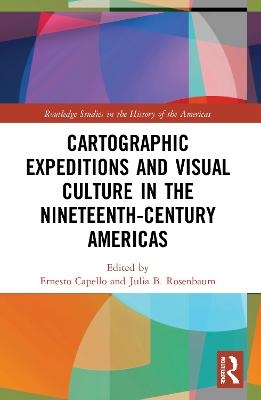
Cartographic Expeditions and Visual Culture in the Nineteenth-Century Americas
Routledge (Verlag)
978-0-367-35026-0 (ISBN)
During the nineteenth century, gridding, graphing, and surveying proliferated as never before as nations and empires expanded into hitherto "unknown" territories. Though nominally geared toward justifying territorial claims and collecting scientific data, expeditions also produced vast troves of visual and artistic material. This book considers the explosion of expeditionary mapping and its links to visual culture across the Americas, arguing that acts of measurement are also aesthetic acts. Such visual interventions intersect with new technologies, with sociopolitical power and conflict, and with shifting public tastes and consumption practices. Several key questions shape this examination: What kinds of nineteenth-century visual practices and technologies of seeing do these materials engage? How does scientific knowledge get translated into the visual and disseminated to the public? What are the commonalities and distinctions in mapping strategies between North and South America? How does the constitution of expeditionary lines reorder space and the natural landscape itself? The volume represents the first transnational and hemispheric analysis of nineteenth-century cartographic aesthetics, and features the multi-disciplinary perspective of historians, geographers, and art historians.
Ernesto Capello is Professor of History at Macalester College. Julia B. Rosenbaum is Associate Professor of Art History and Visual Culture at Bard College.
1. Introduction: The Expeditionary Impulse Part I: Seeing and Not Seeing 3. Triangulating the View: Art and the Great Surveys of the American West in the 1870s 4. Cartographic Representation in the Age of Vernacular Landscape: Pictorial Metaphor in Stephen Long’s Map of the Country Drained by the Mississippi (1822) 5. Seeing Solitary Deserts Full of People: The Chorographic Commission in Colombia’s Eastern Plains, 1856 Part II: Lines and Tracings 6. Intervisible Border: Photographs and Monuments Along the US-Mexico Boundary 7. "Visual Expeditions" Supporting Geopolitical Vindications: Maps, Photographs and Other Visual Devices in the Diplomatic Dispute over the Andes as a Natural Border (1900) 8. Female Eyes on South America: Maria Graham in Brazil 9. Science, Wonder, and Tourism in the Early Mapping of Yellowstone National Park Part III: Art and the Expeditionary Impulse 10. Delineating Land: Art, Mapping, and the Work of Frederic Edwin Church 11. Albert Operti: An Arctic Historical Painter and the Popular Sublime
| Erscheinungsdatum | 13.07.2022 |
|---|---|
| Reihe/Serie | Routledge Studies in the History of the Americas |
| Zusatzinfo | 90 Halftones, black and white; 90 Illustrations, black and white |
| Verlagsort | London |
| Sprache | englisch |
| Maße | 152 x 229 mm |
| Gewicht | 362 g |
| Themenwelt | Kunst / Musik / Theater |
| Geisteswissenschaften ► Geschichte ► Regional- / Ländergeschichte | |
| Geschichte ► Teilgebiete der Geschichte ► Kulturgeschichte | |
| Naturwissenschaften | |
| ISBN-10 | 0-367-35026-2 / 0367350262 |
| ISBN-13 | 978-0-367-35026-0 / 9780367350260 |
| Zustand | Neuware |
| Haben Sie eine Frage zum Produkt? |
aus dem Bereich


